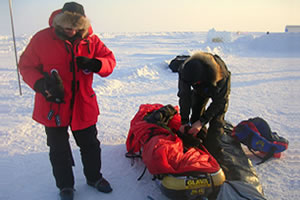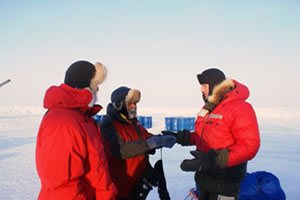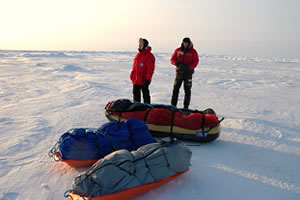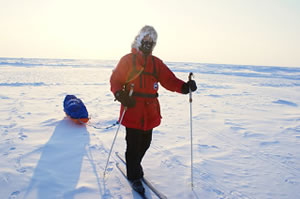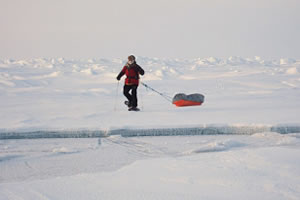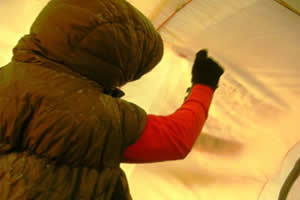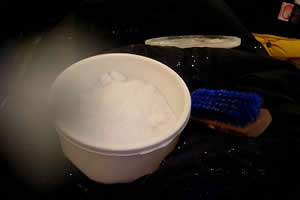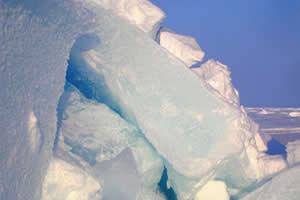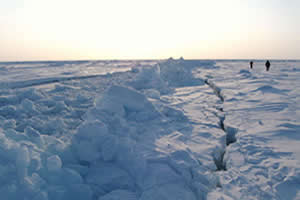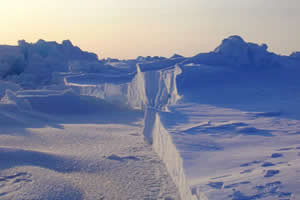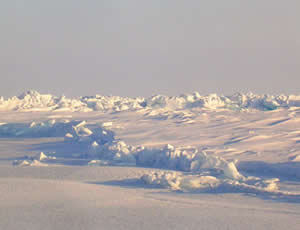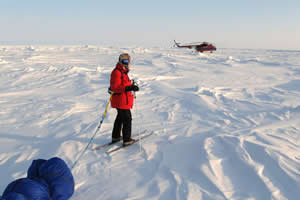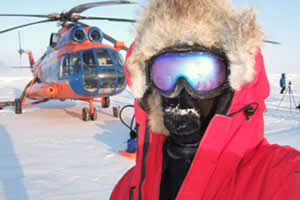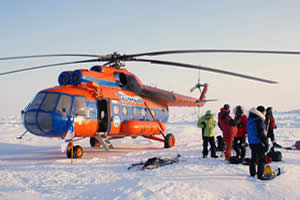Day 1 - Showtime!
And so on Tuesday April 7th it was our turn to take the MI-8 Helicopter to the drop zone, a point just north of 89° 50'. Conditions were good. Weather was clear blue skies with a temperature of -37 C degrees. Ice drift was negative i.e. taking us away from the pole but was no more than a few kilometres per day. Wind strength was variable but up 5-6 metres per second. The plan was to ‘sprint’ to the North Pole in one push from here and then to spend the next 4-5 days completing a number of circumnavigations, exploring the Leads of open water and the Pressure Ridges which form when pressure builds at the junction of two ice sheets as they collide, causing them to fold up suddenly and with tremendous force. These Pressure ridges can be up to 10 metres high and are typically composed of large blocks of ice, some of which are the size of a car and even bigger.
The MI-8 Helicopter on which we were travelling is a curious beast. It is big inside carrying up to 20 people with equipment and requires a crew of 4 to fly. Borge, Salvatore and I were the only North Pole team on the MI-8. Also on board were Victor Boyarsky who heads up the Ice Base at Barneo and a journalist from Frankfurter Allgemeine, the German Newspaper who was writing an article on the ‘goings on’ at the North Pole.
On our way to the drop zone we diverted to bring supplies to a team that had been on the ice for 4 days and who were nearing the Pole. They were really pleased to see us. As they drew near the helicopter I could see they were pretty disheveled and I remember thinking to myself ‘I hope we don’t look like that after 4 days’ – but I’m sure we did! The flight in total lasted about 45 minutes.
The Helicopter arrived at the drop zone, no time was lost in unloading our sleds and equipment on to the ice. Victor gave us all a Russian bear hug by way of goodbye and beckoned us to crouch in close to the helicopter to avoid the icy rotor blast from takeoff. A moment later we were alone, utterly alone.
If I’m honest I’d have to confess to a fleeting wave of terror. Even having trained and acclimatised nothing quite prepares you for the experience. Deep down you know you shouldn’t be here, almost 14,000 feet (4,250 metres)of Arctic Ocean beneath the ice on which you stand, that ice just 5-6 feet (1.5 – 2 metres) thick and often fractured with leads of open water. Add to that temperatures of -45 °C with the wind chill and it soon becomes apparent that survival here for any length of time is a feat in itself!
Our sled harnesses strapped on we skied for the pole, tentatively at first, especially over recently frozen leads, but our confidence increasing as the day went on. It wasn’t long before we met our first Pressure Ridge but it while we needed to get out of skis and harnesses to scramble over it, it wasn’t too bad, only about a 8-10 feet (2-3 metres) high. And so we settled into a routine.
This was a sprint after all so the pace was quick. It was tricky to keep your temperature regulated and avoid overheating. The Inuit people have a saying of trips in the high Arctic - ‘He who sweats dies’ and it is very true because as soon as you stop and your body cools the sweat freezes and quickly you get in to all kinds of trouble as the ice freezes and your body temperature plunges. Also, at the North Pole unlike Antarctica, it is much more humid so when sweat and ice get into your clothes it is almost impossible to get it out. We raced on and took just two short breaks of about 10 minutes. We encountered only modest pressure ridges and only two sections of ‘dodgy’ ice, as in recently re-frozen leads which require that you pay close attention as you ski across. We didn’t encounter any open water on that day.
Snow and ice conditions were generally good but there were few sections where you could glide the skis. There was a lot of ice about which was quite slippery and then there were sastrugi. Sastrugi are wave like sculptures formed by the wind. When they are small they aren’t a problem but when bigger they are awkward for skiing.
After seven and a half hours we arrived at that elusive place 90° North. Big whoops of delight and celebration all round! For me after years of dreaming, planning and more recently training, the day had finally arrived and I was standing at the North Pole – the top of the world. It was a truly wonderful feeling. But this was just the beginning of the adventure. The three of us were alone on top of the world and we had 4 days of exploring the unknown ahead of us. The Ice Base at 89° was established just over a week ago and we were among the first of the teams there this season, so in a sense the North Pole is rediscovered each new season because nobody knows what the winter has done to the ice sheet, nor what the new season’s ice conditions will be like.
Tired, we set up camp and retreated to the tent. We fired up the stove and set to getting the dinner ready. The lighting of the stove came to represent pure bliss as it meant that the tent would warm up and we could take off face masks and down mitts so that we could warm our hands. Dinner typically consisted of freeze dried casserole dishes of the boil in the bag variety and you were well ready for them at the end of the day.
Dinner over, we cranked up the Iridium satellite phone and phoned home to partners and loved ones to let them know we had arrived safely at the Pole. Later we talked for a while and then got ready for bed. Bed time like everything else at the North Pole needs to be planned meticulously. I won’t go into the details here but basically you need to ensure that you don’t have to go to the ‘bathroom’ during the night and for emergencies we had pee bottles. You also need to have a flask of water close by in case of thirst. Sleeping bags need to be tested and proven to -40°C. They are usually of the Mummy variety, wide at the shoulders and tapering in from waist down to be just as wide as the two feet side by side at the bottom. The bag comes up behind the head like a hood to virtually enclose the whole body. At the Pole you sleep with all your clothes on, heavy socks, down booties, jackets and even down Parkas. Because the tent freezes on the inside as soon as the stove is turned off you need to take any delicate equipment into the sleeping bag with you. To protect the face usually a mask is worn and because there is light 24 hours a day I used a mask to cover the eyes. After all that you are now ready for sleep – you wouldn’t want to suffer from claustrophobia.
Day 2
We all slept well that night and next morning dawned a beautiful blue sky day. I shouldn’t say this however because it is in fact wrong. There was no dawn that day. There is only one sunset and one sunrise a year at the North Pole – see ‘Polar Paradoxes’ section. Nor should I say morning as strictly speaking there is no time at the North Pole. It is whatever time you would like it to be!
The morning ritual in the tent began with each person in turn scraping the ice from the section of tent above their head into a bucket. If this wasn’t done then as soon as the stove was lit all of the ice would melt and fall as rain within the tent wetting everything.
Breakfast usually consisted of a tasty porridge and milk with fruit added followed by a cup of coffee or hot chocolate. This was a good high energy slow release food that set you up for the day. We had about two hours form first waking up to eat breakfast, get organized, break camp and get ready to head off for the day. A check on the GPS revealed that during the night, as we slept, we had drifted just over 1 kilometre from the Pole. This was a modest drift, but increasing in pace since we had left Barneo.
And so for four days we explored the region in and around the North Pole, completing 2 circumnavigations and ‘attaining’ the Pole on a total of three occasions. We skied in 2 hour stretches. Ice conditions were good this year following a cold winter. This year too, for the first time in a few years we saw evidence of two year old ice i.e. ice that had seen two winters having survived the previous summer – so it looks like we may have the Ice Cap for another while yet!
While the danger of Pressure Ridges is ever present we did not encounter the birth of any on this trip but they were in evidence everywhere. When two plates of ice collide, at their back end they leave either crevasses or more usually wider gaps and leads of open water. We did not navigate any open water leads but traversed countless recently refrozen ones. These were always approached with caution, testing first by prodding with ski poles and if found to be solid then proceeding ‘gingerly’ across. These leads continue to be a weak point between the plates of ice you tended not to delay too long on them.
Towards the end of Day 2 we were exploring in the region of a large ice hummock. All three of us climbed up but when Salvatore was descending a piece of ice suddenly gave way and Salvatore fell hard, his ribs crashing against a big block of ice. At the time Salvatore seemed to be none the worse for the fall but later back at the tent on twisting he got very sharp stabbing pains in the chest area that almost took his breath away. We powered up the satellite phone and called Salvatore’s doctor in Rome. In the end he could not be sure without x-rays what the extent of Salvatore’s injury was. During the course of the night Salvatore felt it would not be possible to continue and a decision was made to evacuate.
Day 3
Being camped close to the Pole it was chosen as the rendezvous point and so early on Day 3 we again skied to the Pole. At the helicopter we said our goodbyes to Salvatore and made plans to meet up with him when we got back to Spitsbergen. I felt sorry for Salvatore whose grand adventure was being cut short. Now it was just the two of us, Borge and myself. We skied on and on, continuing to explore and taking photographs whenever we got the opportunity. That night we again sought the North Pole and camped there, Borge and I the only two people at the top of the world!
The weather at the Pole for most of the time of our trip was between -33°C to -37°C and on the day with the greatest amount of wind chill taking this down to more than -45°C+. In the tent that night I surveyed the damage to the fingers on both my hands. The tips of all the fingers had that creeping numbness associated with ‘Frost Nip’ the precursor to Frost Bite. The thumb on my right hand was quite badly affected, virging on Frost Bite with the tell tale signs of pale almost colourless skin, with beneath it hard frozen flesh. I had tried to be very vigilant but at -40°C skin contact with metal even for 30 seconds can cause Frost Bite. On Day 2 I had spent a lot of time with exposed hands trying to fix my metal camera to a metal tripod and this is where the damage was done. Thankfully no lasting harm was done and even the thumb would later regain almost full sensation – but it was a valuable lesson!
Day 4
Friday, Day 4 was an eventful day. That morning I woke before Borge. On peeking out of the tent I saw it was an absolutely beautiful blue sky day. I decided to go explore. The sky was a pure blue sky meeting a pristine white frozen sea. The temperature was -35°C but there was not so much as a breath of wind, absolute calm, a rarity at the Pole. The whole experience was almost eerie and other worldly, reminding me of some of those NASA images taken from the surface of Mars. I continued on to a long narrow crevasse by a large Pressure Ridge. The crevasse was quite deep and appeared to extend down to open ocean beneath. The crevasse was narrow enough to jump and I crossed over it to the Pressure Ridge, clambering up and over the ice. I continued to explore, taking photographs of strange salt crystal formations on sections of flat refrozen lead. And then I remembered – the tent. I looked around, everywhere. No sign of it. I scanned a full 360° of the horizon. No tent. Gone!
For an instant there was only blind disbelief as I tried to mentally ‘process’ the situation. I was trying to work out whether or not I was in serious trouble. I was not wearing survival gear. Most of my clothes were of the tent variety, down booties for footwear etc and I would not last long in them. I was annoyed with myself. I had no GPS and I had not paid attention to the golden rule of ensuring ‘line of sight’ to the tent as I explored. I looked around for my tracks but my soft down booties were very efficient at leaving little or no trace of a footprint especially on the ice and harder snow. I continued to scramble over the ice and then as quickly as it had disappeared it reappeared. It had been hidden from view by a large block of ice in the near foreground. Huge sigh of relief all round – I wasn’t going to meet my maker that day – or was I?
Back in the tent Borge was boiling up some snow to make porridge. After a hearty breakfast of porridge followed by a cup of hot chocolate Borge powered up the GPS to locate our position. After 10 minutes it still could not find North. We surmised that we must be close to the Pole and that the GPS was getting confused, because at the Pole the lines of Longitude are bunched very tightly together. We tried powering off and then on again but it to no avail. It was obviously broken. Ordinarily you would have a backup GPS, but in the relative confusion of Salvatore’s evacuation the second GPS had gone back to the Ice Base with him.
Borge didn’t seem worried nor did he say very much. Since the North Pole itself is the default rendezvous for picking up the Polar teams, I asked how far away, in still air would you hear the helicopter. About 3-5 kilometres was the reply. So we would be alright then as long as we were less than this distance from the Pole. On tenter hooks again! If however we had drifted more than 5 kilometres overnight (this would be quite common) then we would most likely not hear the helicopter. And if the weather deteriorated then the helicopter might not be able to see us. Worse still, if the weather deteriorated further and the helicopter were grounded then things would get very tricky indeed!
But, as it happened we were in luck. Sometime after midday we heard the helicopter in the far distance. It was flying to the Pole and it was not much more than a dot on the horizon. The helicopter would be on the ground for two to three hours that day so we had enough time to get there. Luckily visibility was excellent and we had a visual on the helicopter for all the time we skied.
At the Pole a world first was taking place – positively surreal! An American couple living in Hawaii, Richard Browning and Alexis Frederick were getting married at the North Pole. The wedding ceremony itself was officiated by Victor Boyarsky, Head of the Russian Ice Base . After he declared William Browning and Alexis Fredrick husband and wife, the newly married couple exchanged kisses and rings. The bride was, as expected all in white and the groom – in black (arctic) costume. To celebrate the marriage they fired a shoot from an alarm pistol. Right away the married couple started their wedding journey – a ritual dance around the Pole. Having in mind the frosty weather the Champagne started to flow like water only in the warm helicopter and there were toasts in Russian and English.
The wedding ceremony over, the helicopter departed for Barneo Ice Base where the celebrations continued.
Back at the Ice Base it was nice to be in the warmth of the Mess Tent. We met up with fellow travelers, adventurers and explorers and tales were exchanged of past exploits and future plans. Our plan was to depart for Spitsbergen on the next flight, but bad weather there was delaying the flight. We didn’t mind. We were in no hurry.
Day 5
After a number of delays we eventually got away. We arrived in Longyearbyen in the early hours of Saturday. Tired, disheveled, but above all elated. This part of the adventure was a huge success. It was everything I dreamt it would be – and more. Now safely off the Ice Sheet we had three more days on Spitsbergen to decamp and to explore - the adventure continued...






























































































